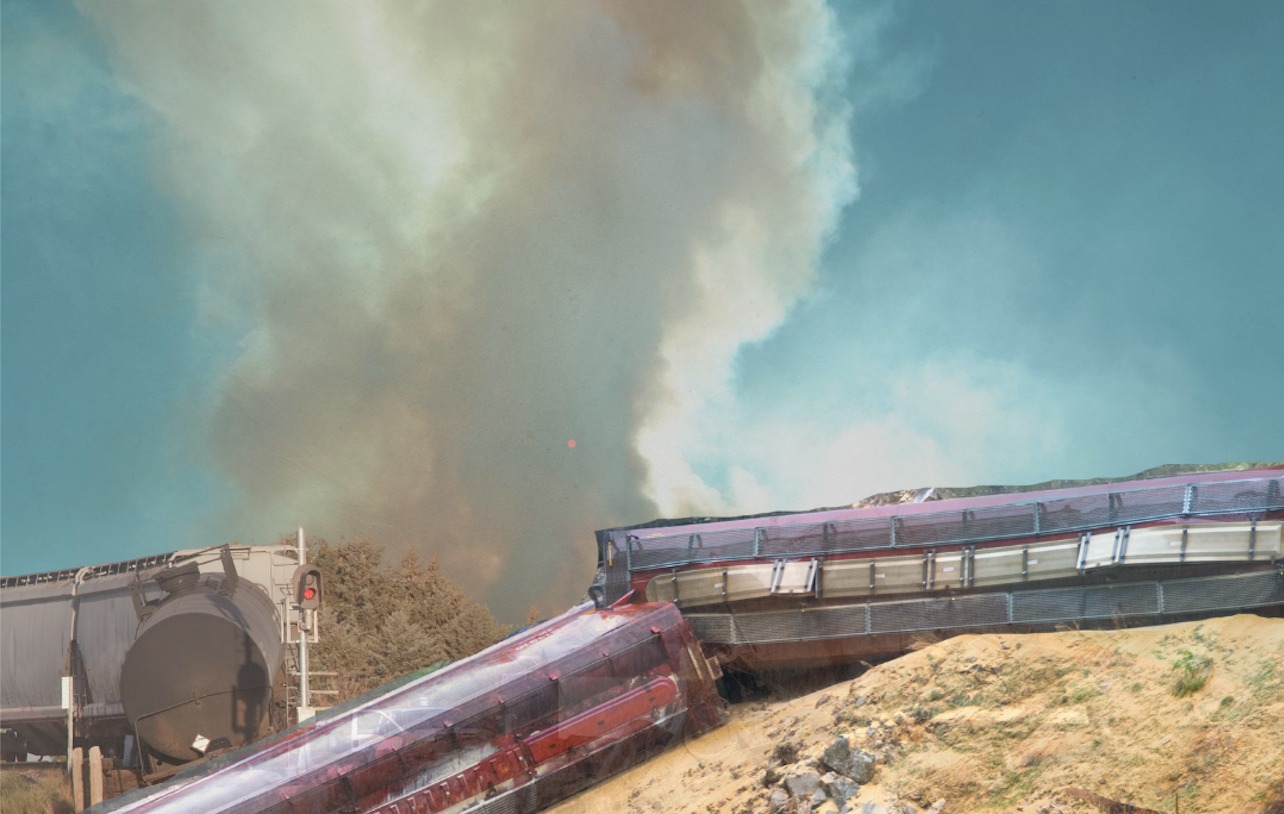
Author: Annika McGraw
Edited by: Muhammed Hani Ahsan
Graphic by: Norie Wright
Introduction
On February 3, 2023, a Norfolk Southern Railway Corporation freight train, carrying volatile organic compounds derailed in East Palestine, Ohio.1 Thirty-eight cars derailed from the track, 11 of which contained hazardous chemicals, resulting in damaged tracks and railcars, evacuation of over 2,000 residents, and eventual reports of health issues faced by residents and their pets.2 The incident ignited concerns among Americans about the consequences of train derailments, especially those involving hazardous chemicals, for local communities and environments. The accident, which has been covered by media and news outlets numerous times over the past few months, has determined the need for a re-evaluation of train safety standards in the United States. Delving into the history of train derailments and the main causes for them, this article will describe the current state of the railroad industry, considerations in transporting hazardous chemicals, and an examination of existing policies and important considerations that contextualize the level of safety standards in the US.
Current Industry Trends
Currently, the US has a total of 140,000 miles of railroad used for passenger travel and freight transport.5 Widespread media coverage of the Ohio accident presented the state of derailments in the US as a grim one, however, United States train derailment rates have been on a steady decline. Reaching an all-time high of 2,495 train derailments in 1980, accidents involving the displacement of a train car from rail tracks have decreased significantly. The average number of derailments per year from 2009 to present-day has ranged from 1,900 to 2,100 derailments.3 After the COVID-19 pandemic, the Bureau of Transportation Statistics found a further decrease in derailments, with roughly 1,750 accidents occurring per year.3
Looking at trends in the United States by specific states, the Bureau of Transportation Statistics estimates that Texas, Georgia, Illinois, Ohio, and Alabama experience the highest number of derailments annually. The Federal Railroad Administration reported that Texas had 190 derailments from 2018 to 2021, resulting in zero deaths and one injury. Over this same period, Georgia had 152 derailments, resulting in zero deaths and ten injuries, and Illinois had 152 derailments with no deaths or injuries. Over the same period, Ohio had 128 derailments with zero deaths or injuries, and Alabama experienced 122 derailments with zero deaths and two injuries. States with over 100 derailments per year face extremely high reportable damage costs over the four-year period in which the data was collected: Georgia reported $37 million, Texas reported $26 million, Illinois reported $13 million, Ohio reported $19 million, and Alabama reported $18 million.6 Reportable damages by train derailments in the United States reached $431,675,487 in 2022.6
Hazardous Chemical Standards and Considerations
The United States Office of Health Compliance Assistance defines hazardous chemicals as “any element, compound, or mixture of elements that is a physical hazard or a health hazard”.9 As per the federal regulations, health hazards include but are not limited to “ chemicals that are carcinogens, tox[ins], reproductive toxins, irritants, corrosive, neurotoxins, hepatotoxins, and chemicals that damage the lungs, skin, eyes, or mucous membranes”.9 According to the Code of Federal Regulations 29, Section 1910.1200(c), a physical hazard is defined as a chemical that is combustible, explosive, flammable, an oxidizing agent, reactive, unstable, water-reactive, or compressed gas. The Hazardous Materials Transportation Act of 1975 gave the DOT the authority to regulate over 3,000 hazardous chemicals. Because of the dangerous nature of many unnamed chemicals, the regulations apply to any type of material that is flammable, corrosive, explosive, or infectious.10 Approximately 3.1 billion tons of hazardous material are shipped via rail in the US every year.11
The number of train derailments involving hazardous chemicals decreased from 2000 to 2022. The total number of derailments in the United States involving hazardous chemicals in 2020 was 382, at least one per day. The number in 2021 was 391, only 35 percent of the total derailments that year. In 2022, the total number was 355, about 20 percent of the total derailments that year. Overall, a declining trend has been reported for derailments involving hazardous chemical spills.7 The Association of American Railroads (AAR) argues that rail is the safest method to transport hazardous chemicals. The agency argues that the hazmat accident rate has decreased by 73 percent since 2000, with more than 99.9 percent of all hazmat moved arriving at its destined location without incident.8 AAR also describes that as an investment in railroad safety increases, rates of train accidents, including derailments, decrease.8 Additionally, alternatives to train transport, such as trucks or planes, pose an even higher risk to community and environmental safety.
Three main classes of hazardous chemicals, freight rail transport of toxic inhalants, petroleum products, and other miscellaneous materials, need to be differentiated to apply safety standards that mold to the relevant characteristics of each hazard type. Toxic inhalants are typically gasses that, if inhaled, result in death. Common examples of transported toxic inhalants include ammonia, anhydrous ammonia, and hydrochloric acid.12 The gaseous nature of these materials makes them spread quickly when released from their containers. Safety standards for these types of materials can be difficult to follow due to the physical nature of each material. For example, some gasses may be denser than others, and, thus, following safety standards that indicate an individual should drop to the floor would result in immediate death during the release of denser chemicals. On the other hand, some chemicals’ density is less so the gas tends to expand upwards, leading individuals to inhale it if they fail to drop to the ground. Transporting this type of material can pose difficulty in making and following reliable standards of safety, while also having a high potential to cause death upon release by derailment.
The second type of material that needs to be considered is petroleum or crude oil. The United States is planning to see a 48% increase in the total number of shipments by rail, rising from 17.8 billion in 2017 to an estimated 24.1 billion shipments in 2040.11 A large part of this increase can be attributed to the rise of fracking and oil production. Due to the danger associated with transporting petroleum and the forecasted increase in oil transit by rail, it is important to consider the safety standards that are applied to these types of shipments. Finally, other miscellaneous hazardous materials are transported daily (24 hours, every day) in the United States. Because of the vast number of chemicals that are transported, shippers and transporters need to be educated in the wide variety of chemicals and their properties. This is and should be a priority for rail companies as it affects operational efficiency, profit, and safety of employees and communities.
Consequences of Train Derailments
Derailments involving hazardous chemicals can harm a community and its environment. The East Palestine accident was notably dangerous due to the involvement of hazardous chemicals, including ones that cause immediate death if inhaled. Of the 38 derailed cars, 11 contained hazardous chemicals that were released into the surrounding environment.13 Six major consequence areas must be considered when evaluating the effect a train derailment can have on a community and the rail industry: (1) human injuries and fatalities, (2) environmental impacts, (3) infrastructure damage, (4) economic impacts, (5) regulatory consequences, and (6) public perception.
Health Consequences
Train derailments can lead to injuries and fatalities among passengers, crew members, and communities near the derailment. When hazardous chemicals are involved in a train derailment, the consequences can be widespread, with hazardous inhalants having the ability to harm a large amount of people in a short time. According to the Federal Railroad Administration, injuries and fatalities in train derailments are one of the major concerns in trying to limit total train derailments in the United States.14
Environmental Consequences
As seen in the 1991 derailment in Dunsmuir, California, a train derailment involving the release of hazardous chemicals can have a lasting impact on the immediate environment, as well as environments that are directly connected through waterways or other ecological paths. The Dunsmuir derailment demonstrated how dangerous chemical spills can be when they enter watercourses. The metam sodium (herbicide) that was released from the train resulted in the death of wildlife and plants and contaminated a major water source for many people. This is just one example of the drastic effects train derailments can have on the environment. These effects can last years and the effect on generations to come is still not wholly known.
Infrastructure Damage
The freight rail industry transports billions of tons of key materials every day, 24 hours per day seven days a week.15 When a train derailment occurs, it can have devastating effects on the rail supply chain in the United States and abroad. Train derailments can seriously damage physical infrastructure, such as railroads, railway equipment, and surrounding community infrastructure. Often it can take long periods to fix and maintain the physical infrastructure needed to run freight trains successfully. Decreasing the number of train derailments can increase operational efficiency while decreasing the total cost of fixing infrastructure damage.
Economic Impacts
Immediate costs for materials lost, physical infrastructure damage, and equipment damage are not the only costs associated with train derailments. Opportunity costs from supply chain disruptions incentivize rail companies to take safety standards seriously to avoid derailments. Additionally, the effects of dangerous chemical release can cause significant damage to surrounding communities and citizens; evacuation and clean-up costs can be expensive. Civil lawsuits can rack up thousands of dollars in costs from settlements to lawyers’ fees. The cost consequences of train derailments encourage suppliers to follow the standards of safety for transporting dangerous chemicals.
Regulatory Consequences
Extensive derailments can encourage government agencies and legislators to enhance regulations for the rail industry. Increased regulations, laws, or policies on the rail industry can prove difficult for rail companies. Rail companies are concerned about any type of regulation that can decrease operations efficiency and profit. Shippers and transporters are incentivized to enhance safety in transport to avoid the potential increase in regulation that will ultimately add extra pressure to the rail industry to balance safety and operational efficiency.
Public Perception
The media has a large influence on the public’s perception and trust of the rail industry. In recent years, train derailments have flooded the media when they occur. News outlets spend large amounts of time reporting on the details and consequences of train derailments; this constant reporting can sway public perception.
Influencing Causative Factors
Because of the declining rate of train derailments in the United States from 1980 onwards, it has been more challenging to determine the factors that influence train derailment accidents. According to a study by Barkan et. al, researchers analyzed research derailment data. They determined that the speed of transit increases and the number of cars per train is highly correlated with releasing hazardous chemicals.16 A more recent probabilistic modeling study determined that transporting hazardous chemicals via train can lead to higher levels and more types of chemicals being released into the environment due to derailments, as the capacity capabilities of train transport are higher than the capacity of truck transport.17 Additional factors specific to the US include infrastructure failures and track defects, equipment failures, improper train handling and human error, and weather.
Infrastructure: Track and Equipment Defects and Failures
Physical infrastructure has the largest influence on train derailment rates in the US. Worn-out rail tracks, insufficient maintenance, and rail misalignments are all physical track issues that can lead to derailments. In an analysis by Liu et. al, researchers found that there was a multitude of physical infrastructure problems that led to derailments from 2001 to 2010. Some common issues (and their frequencies) include broken rails (15.3 percent), issues with track geometry (7.3 percent), bearing failures (5.9 percent), and broken wheels (5.2 percent).17 The majority of physical infrastructure problems relate to issues with track widening and broken equipment. Infrastructure problems related to track problems had a higher number of rail cars that derailed, leading to more catastrophic consequences when track issues were the cause of derailments (Liu, 2012). Equipment defects and failures are the next most common cause of train derailments. Mechanical failures in locomotives, railcars, and wheels and bearings lead to train derailments that can be catastrophic. According to an article written by Li et. al, equipment defects, and track failures account for 60 percent of derailments in 2022.17
Improper Train Handling: Human Error
Another factor that can lead to train derailments is human error, resulting from improper train handling and mistakes made by train operators, operation and maintenance crews, and other employees. Train operators can cause derailments by exceeding speed limits, failing to acknowledge signals, and failing to respond quickly and appropriately to railway conditions. Maintenance crews that fail to secure track properly or identify potential defects and failures in railways can lead to derailments. Communication errors between dispatchers and operating crews can lead to derailments by crews failing to acknowledge track conditions and route changes. Failure to correctly train crew and employees can lead to mistakes and human error when operating freight trains. Inadequate or insufficient training is a major issue in the railroad industry especially when dealing with hazardous chemicals. Additionally, human error can arise from stress and fatigue, as rail workers tend to work odd and long hours.18
Weather and Other Environmental Factors
Adverse weather can greatly affect train safety and lead to train derailments. Weather can also exacerbate existing infrastructure and equipment defects. The Federal Railroad Administration’s Railroad Extreme Temperature Action Plan outlines measures to address the challenges that arise with inclement weather. These proactive strategies can help minimize disruptions caused by weather, increasing operational efficiency. Even though this plan helps rail operators mitigate the risk of derailment, regardless of the proactive processes followed, weather can still cause derailments and damage to track and railcars.6 Additional considerations that influence train derailments include locations. Most train derailments occur in rail yards. The AAR estimated that 76 percent of all freight train derailments in 2022 happened in the railyard. Of these 731 railyard derailments, only one incident involved hazmat, with 735 incidents involving no hazmat release, injuries, or fatalities.5
Considerations in US Regulations and Policies
The US’s response to hazardous chemical releases has had a huge effect on the industry and derailment frequencies. Government agencies and lobbyists argue for decreased government regulations on material transport, as complex and intense regulation can lead to decreased operational efficiency and profit for rail carrier companies. These companies have an inherent incentive to implement expansive safety standards as train derailments can have lasting effects on a company’s profit margin, bottom line, and overall ability to succeed in the industry. This incentive should be further capitalized by the US government to encourage high standards of safety and to foster the continuation of decreasing train derailment trends.
There are a multitude of ways to increase safety when transporting hazardous materials: using a pilot car, placing a leading locomotive before the train to observe potential hazards, or organizing train cars in a way that decreases derailment rates. These various safety standards, while effective for decreasing derailments, are expensive and decrease operational efficiency. The US rail industry is driven by competition, and rail companies are incentivized to safety standards while balancing operational efficiency.
Conclusion
Overall, implementing technological advancements, increasing training, and more robust communication will continue to have a positive effect on decreasing derailments in the United States. Focusing on technological advancement and increased use of new technology, such as hotbox detectors, will continue to decrease the chances of train derailments and better the total transportation of goods, increasing operational efficiency and leading to a more reliable supply chain. Detailed and up-to-date training will provide railroad operators, employees, and first responders will allow them to have the necessary tools to effectively respond to accidents when they do occur. Increasing communication standards and implementing better communication standards among rail companies, surrounding communities, and government agencies will not only positively affect the day-to-day operation of freight rail transport, but it will also close regulatory gaps that exist between government agencies and private rail companies.
In conclusion, while current safety standards and operational procedures are effective in mitigating train derailments in the US, there are always ways to improve. Many of the issues that cause derailments are due to physical infrastructure failures and defects. Additionally, human error and improper train handling can also cause derailments. Technological advancements, increased training, and better communication between industry employees and government agencies can decrease train derailments in the United States.
References
[1] “East Palestine, OH, Train Derailment and Hazardous Materials Shipment by Rail: Frequently Asked Questions,” Congressional Research Service. 24 February, 2023, https://sgp.fas.org/crs/misc/R47435.pdf
[2] Hauser, C, “After the Ohio Train Derailment: Evacuations, Toxic Chemicals and Water Worries,” The New York Times, 23 June, 2023, https://www.nytimes.com/article/ohio-train-derailment.html
[3] “Train Fatalities, Injuries, and Accidents by Type of Accident | Bureau of Transportation
Statistics,” Bureau of Transportation Statistics, 2023, https://www.bts.gov/content/train-fatalities-injuries-and-accidents-type-accidenta
[4] White, J. H., The American Railroad Freight Car: From the Wood-Car Era to the
Coming of Steel, Johns Hopkins University Press, 1993.
[5] “Freight Rail & Supply Chains,” Association of American Railroads, 18 October, 2023.
[6] Train Accidents by Type | FRA. (2023). Federal Railroad Administration https://railroads.dot.gov/accident-and-incident-reporting/train-accident-reports/train-accidents-type
[7] Hazardous Materials Fatalities, Injuries, Accidents, and Property Damage Data | Bureau of Transportation Statistics. (2022). Bureau of Transportation Statistics. https://www.bts.gov/content/hazardous-materials-fatalities-injuries-accidents-and-property-damage-data
[8] Ohlhaber, K. (2017, December 13). Rail is the Safest Mode for Hazmat | Association of American Railroads. Association of American Railroads.
[9] Federal Hazmat Law: An Overview of Federal Laws for Hazardous Materials Transportation.
(2021, September). United States Department of Transportation.
efaidnbmnnnibpcajpcglclefindmkaj/https://www.phmsa.dot.gov/sites/phmsa.dot.gov/files/2021-09/Hazmat%20Law%20Overview_September-2021_0.pdf
[10] Cooperative Research for Hazardous Materials Transportation. (2005). https://doi.org/10.17226/11198
[11] Scarrow, T. (2021, May 20). 3 potential risks when transporting hazardous materials by rail.
Ishn.com; ISHN. https://www.ishn.com/articles/112984-potential-risks-when-transporting-hazardous-materials-by-rail
[12] Hazardous Substances Released During Rail Transit — 18 States, 2002–2007. (2007).
Center for Disease Control. https://www.cdc.gov/mmwr/preview/mmwrhtml/mm5622a2.htm
[13] Walker, M. and Eavis, P., “N.T.S.B. Convenes Hearing in East Palestine to Examine Train Derailment,” The New York Times. 22 June, 2023, https://www.nytimes.com/2023/06/22/us/politics/train-derailment-east-palestine-ntsb.html#:~:text=Ultimately%2C%2038%20cars%20ended%20up,materials%2C%20according%20to%20the%20agency.&text=No%20one%20died%20or%20was,or%20the%20municipal%20water%20system.
[14] Accident Data as reported by Railroads. (2019). Federal Railroad Association. https://safetydata.fra.dot.gov/OfficeofSafety/publicsite/on_the_fly_download.aspx
[15] Freight Rail & Supply Chains – AAR. (2023, October 18). Association of American Railroads.https://www.aar.org/issue/supply-chain/
[16] Barkan, C.P., Dick, C.T., & Anderson, R.A. (2003). Railroad Derailment Factors Affecting
Hazardous Materials Transportation Risk. Transportation Research Record, 1825, 64 –
74. Burlington Northern Agrees to Pay $1.5 Million to Settle Claims for Three Spills. (1995, 4 April). United States Department of Justice. https://www.justice.gov/archive/opa/pr/Pre_96/April95/188.txt.html
[17] Liu, X., Saat, M.R., & Barkan, C.P. (2014). Probability analysis of multiple-tank-car release
incidents in railway hazardous materials transportation. Journal of hazardous materials,
276, 442-51.
[18] Railroad Workers: Occupational Outlook Handbook: U.S. Bureau of Labor Statistics. (2023,
September 6). U.S. Bureau of Labor Statistics. https://www.bls.gov/ooh/transportation-and-material-moving/railroad-occupations.htm





